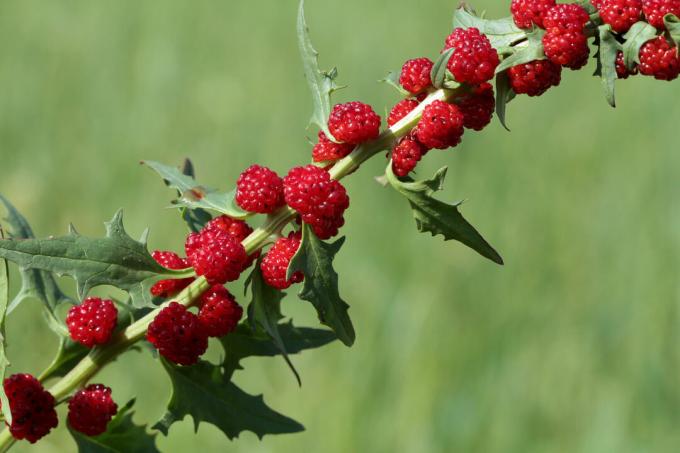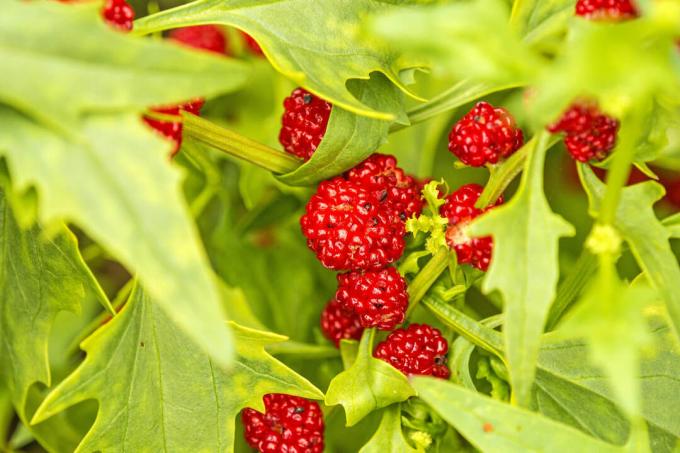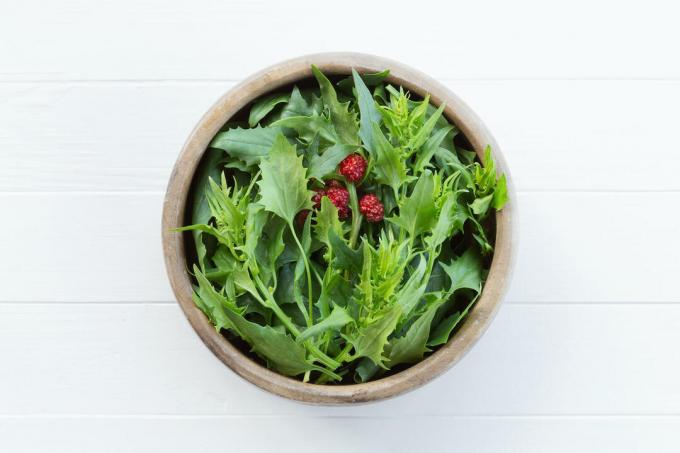What is the difference between real strawberry spinach and spiked strawberry spinach? How does the cultivation of strawberry spinach work and what should be considered when harvesting? You can read this and more in our special article.

Strawberry spinach - this almost forgotten leafy vegetable is unfortunately only known to a few today. Too bad, because the vegetable not only scores with an extraordinary appearance, but also shines thanks to its uncomplicated cultivation and high nutrient content.
contents
- Strawberry spinach: characteristics and origin
- The types of strawberry spinach
-
Growing strawberry spinach: This is important to note
- The right location for strawberry spinach
- How to sow strawberry spinach
- Care of strawberry spinach
- Multiply strawberry spinach: this is how it works
- Is Strawberry Spinach Hardy?
- Harvest strawberry spinach
- storage
Strawberry spinach: characteristics and origin
The strawberry spinach (
Blithum virgatum or Blitum capitatum) belongs to the foxtail family (Amaranthaceae). Even if the strawberry spinach is rather unknown, there are many familiar faces in its family: In addition to its namesake, the real spinach (Spinacia oleracea), the strawberry spinach is also with quinoa (Chenopodium quinoa) and Beetroot (Beta vulgaris) related. But where does the unusual name of strawberry spinach come from? In fact, a look at the plant can quickly explain the name: the bright red fruits of the strawberry spinach are visually (though not tastefully) reminiscent of strawberries. Its green to light green leaves resemble those of spinach with their triangular and deeply serrated shape only removed, but are prepared similarly to this one, so that the second part of the name is also easy to explain leaves.The herbaceous, mostly annual cultivated plant is 20 to 60 centimeters high with bare, upright stems and a basal rosette of leaves. Strawberry spinach leaves make a tasty and nutritious addition to the kitchen. However, it is often not only grown as food - thanks to its striking red fruits, strawberry spinach is also a popular ornamental plant for the garden or balcony.

Little is known about the origin of strawberry spinach: today it is assumed that the plant originally came from Asia Minor and the Orient and was carried by the Moors to southern Europe, especially Spain came to us. Unfortunately, leafy vegetables were not able to fully establish themselves here. Although it was cultivated in cottage gardens as an ornamental and useful plant for a few centuries, it was then increasingly replaced by spinach. Strawberry spinach finally disappeared from our menus about a hundred years ago. After that, the pretty useful plant almost fell into oblivion - but fortunately it can still be found in German gardens today, albeit rarely. In particular, the rediscovery of old types of vegetables in recent years has helped strawberry spinach to gain new popularity. In the meantime, some seed retailers also offer strawberry spinach seeds (some of them also in organic quality). As a wild plant, strawberry spinach is only found in the mountains of Northwest Africa, in western Eurasia and rarely in the Mediterranean area.

The types of strawberry spinach
Under the generic term strawberry spinach, two types are distinguished:
- The Real Strawberry Spinach (Blithum virgatum)
- The spiked strawberry spinach (Blitum capitatum).
Both species are closely related. Although they have visual differences, they are almost identical in taste and preparation. You can see real strawberry spinach (Blithum virgatum) because it grows taller overall and the fruits are distributed over the stem and are located in the leaf axes. In the case of spiked strawberry spinach, on the other hand, the fruits are bundled on a false ear. In contrast to the real strawberry spinach, the spiked strawberry spinach probably does not come from the Orient, but from North America, and is still found there today. Due to the low economic importance of strawberry spinach in commercial cultivation, different varieties were never bred. For this reason, strawberry spinach is still almost exclusively divided into the two types mentioned above.

Growing strawberry spinach: This is important to note
Growing strawberry spinach is not difficult - on the contrary: strawberry spinach can be cultivated in almost any garden be, because it is equally suitable for cultivation in the bed as well as in the planter on the terrace or in the Balcony. The ground spinach is particularly interesting for the mixed culture: Between potato or runner beans, it not only offers a real eye-catcher in your garden, but also protects the soil from erosion and makes optimal use of the available space. In addition, the real strawberry spinach has proven to be an ideal neighbor for spring onions, the spiked strawberry spinach as a good intermediate culture for celery.
The right location for strawberry spinach
Full sun locations are perfect if you want to cultivate the strawberry spinach. But in most cases, partially shaded locations are also suitable for growing strawberry spinach. When choosing the location for the strawberry spinach, particular attention is paid to the right water supply Pay attention: Strawberry spinach does not like high temperatures or drought, but waterlogging also makes it harder create. A humus-rich, deep, loamy-sandy soil in which there is no waterlogging is therefore optimal as a location. In addition, when growing strawberry spinach, care should always be taken to ensure a diverse crop rotation: In order to maintain the vitality of the soil, Strawberry spinach and its relatives from the foxtail family (spinach, chard, beetroot) are not consistently planted in the same location will. If possible, foxtail plants should be sown in a different location each year, otherwise one location should be used for cultivation for a maximum of three years in a row.

How to sow strawberry spinach
Sowing strawberry spinach outdoors should ideally take place between March and June. Dates for sowing into August are also possible, but this increases the risk of early flowering. Because the strawberry spinach to the germinate in the dark counts, it is particularly important for reliable germination to ensure that the seeds are planted deep enough (about 2-3 cm) into the soil. Between the individual plants, distances of 25-30 cm are recommended, in rows of 15 cm - so each plant has enough space to develop. If there is a risk of late frosts, for example when sowing particularly early in March, it is advisable to also pay attention to frost protection. It has proven useful to cover the bed with garden fleece until the danger of late frosts has passed.
The strawberry spinach thrives optimally when it finds the right soil conditions: A loose, sandy-loamy and deep soil is ideal. If the garden cannot offer this, it is advisable to cover the existing soil with a high-quality potting soil, for example the Plantura organic universal soil, upgrade. Very heavy, clayey soils should also be mixed with about a third of sand so that water can drain off well over the long term.

If you want to harvest your strawberry spinach earlier, you can bring it indoors from March. To do this, put three to four seeds of the strawberry spinach in a small pot with a diameter of at least 8 cm. A potting soil such as this is ideal for growing strawberry spinach Plantura organic herbs & seed soil, as this is loose and rather low in nutrients, which optimally supports the root growth of the small plants. Room temperature during germination should be between 16°C and 22°C throughout the day. After germination, there are two options for the strawberry spinach: if late frosts are no longer to be expected outside, the plants can move to their new home in the bed. Of course, the above-mentioned distances must be maintained in order to ensure ideal development and to avoid mildew infestation. If it is still too cold or if the strawberry spinach should then be cultivated in tubs, you can do that Put leafy vegetables in tufts of 3-4 plants in small pots with universal soil and continue here care for.
Care of strawberry spinach
Strawberry spinach is generally considered to be very easy to care for. Nevertheless, you should consider a few points if you want to take care of your plants as well as possible: A sufficient supply of nutrients is absolutely necessary for a high-yield and worthwhile crop. For example, preparing the soil by mixing in compost has proven itself and is usually sufficient. If you don't have compost available for fertilizing, you can alternatively use an organic-based fertilizer, such as the Plantura organic universal fertilizer, use for nutrient supply. Organic fertilizers have the advantage that they have a natural long-term effect and can provide the plants with nutrients as needed.
As with most leafy greens, strawberry spinach doesn't need to be pruned regularly; instead, the leaves are separated at harvest.
The care of strawberry spinach also includes the regular supply of water: especially when it is hot temperatures, it is necessary to water the strawberry spinach sufficiently to keep the leaves as tender as possible keep. Mornings and evenings are ideal times for watering, since the temperature is lowest here, meaning that little water evaporates. Occasional hoeing between the plants and removing weeds also have a positive effect on development.
Tip: Strawberry spinach is very sensitive to a lack of nitrogen in the soil and indicates this as follows: Young leaves stay green a little longer, while older ones lighten evenly and even turn completely yellow will. Such a deficiency should be quickly treated with a fast-acting fertilizer, such as our liquid Plantura organic green plant fertilizer, to be balanced.

Multiply strawberry spinach: this is how it works
Buying new strawberry spinach seeds every year? It doesn't have to be. If you want to avoid buying new seeds every year, you even have two options for growing strawberry spinach yourself:
- The own seeding of the strawberry spinach: Self-seeding is particularly easy - some plants are simply not cut, but allowed to grow until seed maturity. Since the strawberry spinach is considered to be particularly strong sowing, numerous seeds are distributed over the characteristic fruits in the area. As a result, numerous new plants will grow all around the next spring.
- Extracting the seeds from the fruits: If you want to avoid uncontrolled propagation of strawberry spinach or want to plant it somewhere else next year, you should remove ripe fruits in good time. But instead of throwing away the red balls, they can also be used to produce seeds. The seed is now thoroughly freed from the pulp and stored in a dark, dry, cool place, where it awaits its next use.

Is Strawberry Spinach Hardy?
In contrast to its close relative, the spinach, the strawberry spinach is often not hardy in our latitudes. Although there are cases in which strawberry spinach survives temperatures down to -10 °C and sprout again in spring, the plant is usually cultivated in Germany as an annual crop. In contrast, the seeds, especially when self-sowing, can easily cope with the colder ones Withstand temperatures in the bed and begin to germinate next year if provided with sufficient soil are covered.
Harvest strawberry spinach
Two to three months after sowing, the time has finally come – the harvest of the strawberry spinach is about to begin. As with spinach, strawberry spinach (depending on when it was sown) can be harvested again and again throughout the summer up to September. Either individual leaves are plucked off as required or the entire shoot is cut off about 30 cm above the ground with a sharp knife. This then drives out again so that it can be harvested again a few weeks later. Incidentally, the flavor and nutritional content of strawberry spinach is at its best when the plant is not yet in bloom. The ideal time to harvest leaf spinach is therefore just before flowering.

storage
The harvest is in and the strawberry spinach is ready for the kitchen. But what now? Storing strawberry spinach in particular poses a challenge for many: If the leaves are stored in the kitchen, they quickly become limp and unappetizing. If you want to prevent this, you should either use the strawberry spinach immediately after harvesting or wrap it in damp kitchen paper and put it in the fridge. In this way, the leaves can be stored for another five to six days.
Strawberry spinach can be used in many ways in the kitchen: the leaves are prepared like real spinach, for example steamed and served as a vegetable side dish. But strawberry spinach is also very popular as an ingredient in soup, filling for puff pastries or as a quiche. The young leaves are particularly tender and can therefore also be eaten raw, for example in a wild herb salad. Even if the colorful fruits are visually reminiscent of strawberries or raspberries, they are rarely used in the kitchen. Although they are not poisonous, their taste is generally described as bland and similar to that of beetroot, which is why they are rarely used in the preparation of dishes. On the other hand, they are well suited as a colourful, edible decoration, for example to top off a strawberry spinach salad.
In terms of nutritional content, however, strawberry spinach is superior to spinach. It scores particularly well with a high proportion of vitamin C, iron and trace elements. However, people with kidney problems or rheumatism should be careful with strawberry spinach: the oxalic acid it contains can be harmful in high quantities.

Would you like to learn more about unusual and old types of vegetables? Many interesting and well-tried types of vegetables can be found in our article "10 Almost Forgotten Vegetables“.



